Karnataka Board Class 9 Maths Chapter 11 Areas of Parallelograms and Triangles Ex 11.2
Question 1.
In Fig., ABCD is a parallelogram, AE ⊥ DC and CF ⊥ AD. AB = 16 cm., AE = 8 cm, CF = 10cm, find AD.

Solution:
ABCD is a parallelogram.
AE ⊥ DC and CF ⊥ AD.
AB = 16 Cm, AE = 8 cm, CF = 10 cm, then AD = ?
(i) Area of ABCD = base × altitude
= DC × AE ( ∵ AB=DC)
= 16 × 8
= 128 sq. cm.
Whether ABCD is quadrilateral, ADCB is a quadrilateral.
∴ Area of ADCB = 128 sq. cm.
Base = AD = ?
Altitude, CF= 100 cm.
Base × Altitude = Area
AD × CF = 128
AD × 10 = 128
∴ AD = \(\frac{128}{10}\)
∴ AD = 12.8 cm.
Question 2.
If E, F, G and H are respectively the mid-points of the sides of a parallelogram ABCD, show that

ar(EFGH) = \(\frac{1}{2}\) ar(ABCD)
Solution:
Data: E, F, G and H are mid-points of the sides of a parallelogram ABCD,
To Prove: area (EFGH) = \(\frac{1}{2}\) area (ABCD)
Construction: HF is joined.
Proof: Now, AD = BC and AD || BC
∴ 2AH = 2BF
∴ AH = BF and AH || BF
∴ AHFB is a parallelogram.
Similarly, HDCF is a parallelogram.
Now, DEHF and Quadrilateral AHFD are on base HF and in between HF || AB.
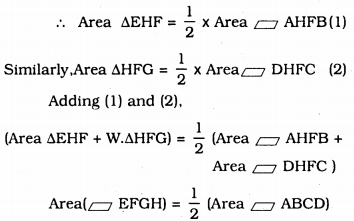
Question 3.
P and Q are any two points lying on the sides DC and AD respectively of a parallelogram ABCD. Show that ar (PAB) = ar (BQC).
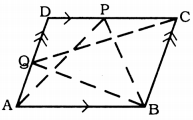
Solution:
Data: P and Q are any two points lying on the sides DC and AD respectively of a parallelogram ABCD.
To Prove: ar(∆APB) = ar(∆BQC)
Proof: ABCD is a parallelogram.
∴ AB || DC AB = DC
AD || BC AD = BC
Now ∆APB and ABCD are on same base AB and in between AB || DC
∴ Area(∆APB) = \(\frac{1}{2}\) Area ABCD) ……… (i)
Similarly, ∆BQC and BADC are on the same base BC and in between BC || AD.
∴ Area(∆BQC) = \(\frac{1}{2}\) Area(ABCD) ………. (ii)
From (i) and (ii),
∴ Area(∆APB) = Area (∆BQC).
Question 4.
In Fig., P is a point in the interior of a parallelogram ABCD, Show that
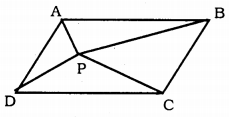
(i) ar.(ABP)= ar(PCD) = \(\frac{1}{2}\) ar (![]() ABCD)
ABCD)
(ii) ar(APD)+ ar(PBC) = ar(APB) + ar(PCD)
(Hint: Through P, draw a line parallel to AB).
Solution:
Data : P is any point in the interior of a parallelogram ABCD. PA, PB, PC and PD are joined.
To Prove: (i) ar(ABP= ar(PCD)= \(\frac{1}{2}\) ar (![]() ABCD)
ABCD)
(ii) ar(APD) + ar(PBC)= ar(APB) + ar(PCD)
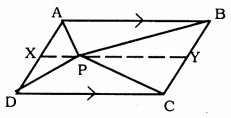
Construction: AB || XY is drawn through P.
Proof: (i) XY || AB || DC
∴ ABYX and XDCY are parallelograms.
∆APB and ![]() ABYX are on base AB and in between AB||XY.
ABYX are on base AB and in between AB||XY.
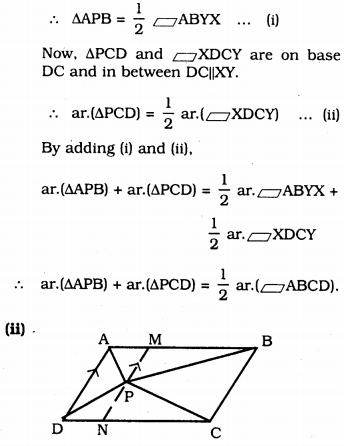
Construction: AD || MN is drawn through P.
Proof: ∆ADP and ![]() ADMN lie on the base AD and in between AD || MN
ADMN lie on the base AD and in between AD || MN
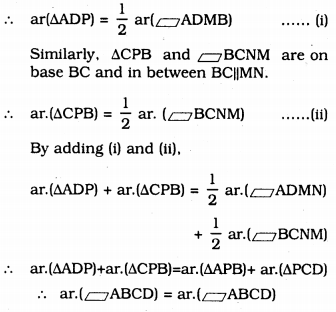
Question 5.
In Fig., PQRS and ABRS are parallelograms and X is any point on side BR. Show that
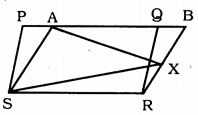
(i) ar.(PQRS) = ar.(![]() ABRS)
ABRS)
(ii) ar.(AXS) + = \(\frac{1}{2}\) ar. (![]() PQRS).
PQRS).
Solution:
Data: PQRS and ABRS are parallelograms and X is any point on side BR.
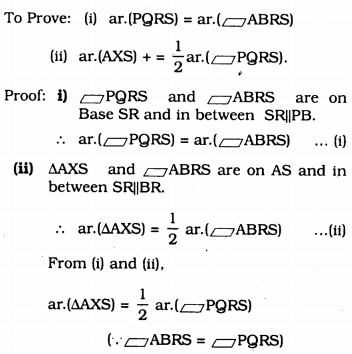
Question 6.
A farmer was having a field in the form of a parallelogram PQRS. She took any point A on RS and joined it to points P and Q. In how many parts the fields is divided? What are the shapes of these parts? The farmer wants to sow wheat and pulses in equal portions of the field separately. How should she do it?
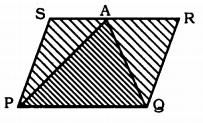
Solution:
If AP and AQ are joined ![]() PQRS is divided into three triangles, ∆SAP, ∆APQ and ∆ARQ.
PQRS is divided into three triangles, ∆SAP, ∆APQ and ∆ARQ.
∆APQ and ![]() PQRS are on base PQ and in between PQ || SR.
PQRS are on base PQ and in between PQ || SR.

From (i) and (ii).
∴ ar.(∆APQ) = ar.(∆SAP) + ar.(∆ARQ)
∴ Farmer can use the part of the field to sow wheat,
i.e. Ar. (∆SAP + ∆ARQ) and in the same area, he can use the Area of ∆APQ to sow pulses.